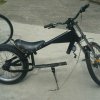TheSignGuy
Member
Hello,
Sign guy here,
So I have decided that my second build will be powered by x2 4500 PSI C02 tanks.
My main issue is how does the tank systems work crazy as it sounds I've have never installed a paintball tank before so I am highly unaware how the release systems set up.
What parts would I need to activate the c02 vs a standard air tank.
From my knowledge, air tank (lb) is < a c02 tank on pressure
The break down of psi to pounds is very so much differant I do know the starting of this system will require me to get up to speed of 20mph before engaging the system as a booster.
I would prefer higher pressure vs lower pressure and less weight over tank weight so c02 is the best option.
Last what would be the best hose line system for this bike I would like silicone hoses or pex fittings vs standard compressed type lines.
This budget will have to be very low quality.
I also have one last concern I just thought of if a 2t weed eater engine is ran without lubrication wouldn't that cause the rings not to seal overtime then leak out all my c02? Lubrication sounds like a bigger issue if the carb is removed and a oil fitting is attatched over the existing carb position a reed model should allow the intake to suck in oil as needed right?
Sign guy here,
So I have decided that my second build will be powered by x2 4500 PSI C02 tanks.
My main issue is how does the tank systems work crazy as it sounds I've have never installed a paintball tank before so I am highly unaware how the release systems set up.
What parts would I need to activate the c02 vs a standard air tank.
From my knowledge, air tank (lb) is < a c02 tank on pressure
The break down of psi to pounds is very so much differant I do know the starting of this system will require me to get up to speed of 20mph before engaging the system as a booster.
I would prefer higher pressure vs lower pressure and less weight over tank weight so c02 is the best option.
Last what would be the best hose line system for this bike I would like silicone hoses or pex fittings vs standard compressed type lines.
This budget will have to be very low quality.
I also have one last concern I just thought of if a 2t weed eater engine is ran without lubrication wouldn't that cause the rings not to seal overtime then leak out all my c02? Lubrication sounds like a bigger issue if the carb is removed and a oil fitting is attatched over the existing carb position a reed model should allow the intake to suck in oil as needed right?


